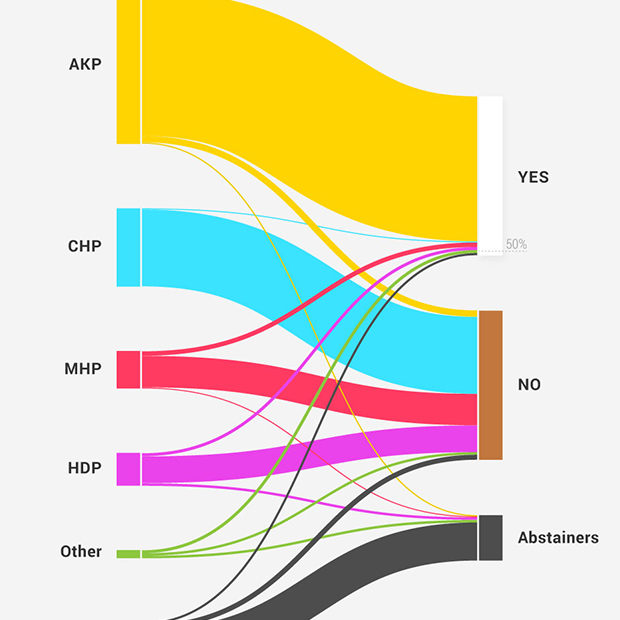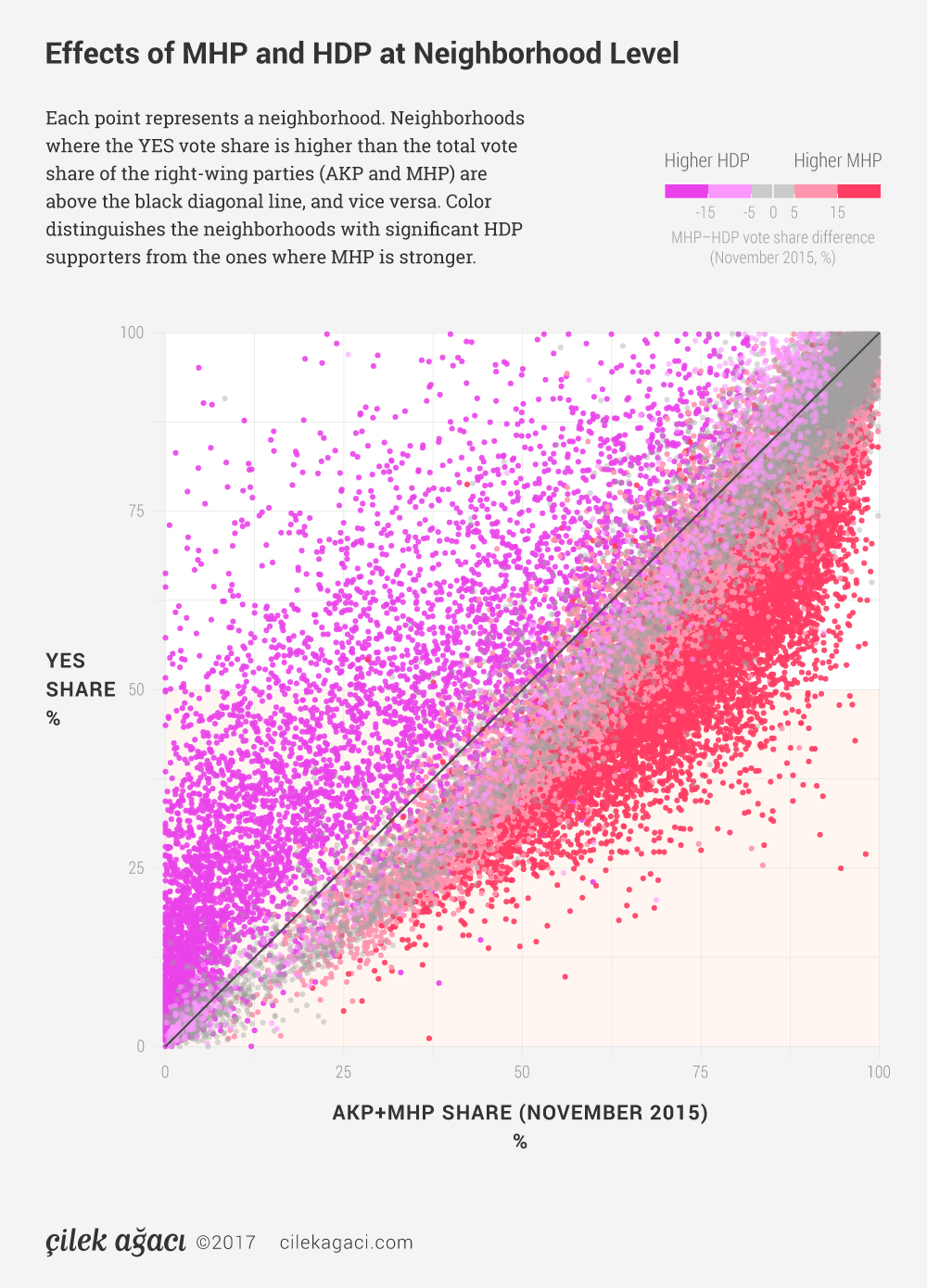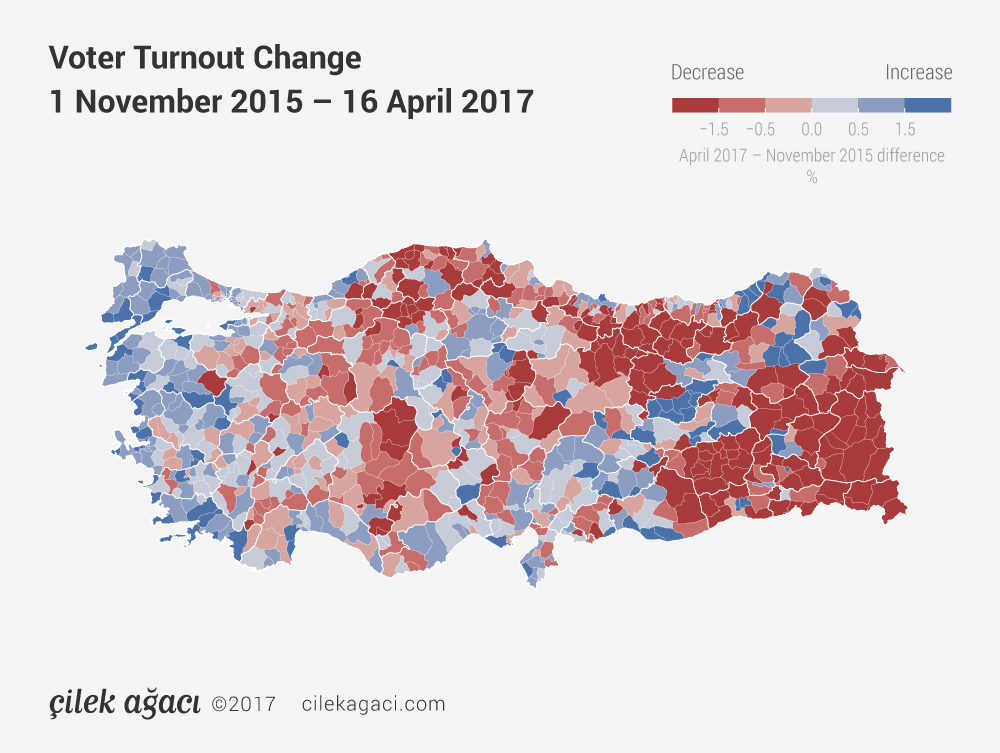
Summary
On April 16, Turkey held a constitutional referendum while the country was still under the state of emergency declared last summer after the failed coup attempt. The constitutional change involves a transition from the current parliamentary system to a presidential system that transfers the executive power to the president who appoints all ministers and top judiciary officials, including the majority of supreme court judges. The Turkish presidential system also allows the president to issue decrees, declare state of emergency, and dissolve the parliament for re-elections.
Supporters of the constitutional changes were Erdogan’s ruling Justice and Development Party (AKP) and the Nationalist Movement Party (MHP), a right-wing bloc that received 61 percent of votes during the previous elections. The opposition bloc consisted of the secular and center-left Republican’s People Party (CHP) and pro-minority, democratic socialist People’s Democratic Party (HDP). The constitutional change was approved by 1.4 percentage points above the absolute majority. In this research brief, we analyze voting behavior of the Turkish electorate body in the referendum.
The fact that the country was under a state of emergency [1, 2], the recent armed conflict in Southeast Anatolia which triggered the displacement of as many as 400,000 people [4, 5], and the constrained voice of the political opposition raised questions about the referendum results [3, 9]. During and after the referendum, the opposition bloc and independent observers raised serious concerns of irregularities. [6, 7, 8, 9]. In an effort to declare the referendum outcome null and void, the main opposition Republican People’s Party (CHP) appealed to the Supreme Committee of Elections, the constitutional institution that regulates the elections in Turkey. The reader should keep in mind these circumstances when interpreting the findings. Our analysis takes the election results as given.
According to our estimates, AKP and CHP voters followed the party leadership, and overwhelmingly voted for YES and NO, respectively. In stark contrast to their party line, at least 77 percent of MHP supporters voted for NO. Surprisingly, at least 6 percent of the pro-Kurdish Peoples’ Democratic Party voters supported the constitutional change and played a pivotal role in the referendum outcome. Voter turnout increased in western Turkey while it decreased in the East. The Sankey diagram summarizes the voter transitions between November 2015 General Elections and the April Referendum, estimated by ecological inference and using the election outcomes from 970 districts.
Findings
The regional differences between November 2015 General Elections to April 2017 Referendum is striking (Map 1). The YES bloc is substantially below their electoral support in all districts but the East and Southeast of Turkey. Despite overperforming in eastern Turkey, the YES bloc ends up 10 percentage points below their cumulative voter support (61.0% vs. 51.4%).
In almost all districts in Middle and Western Anatolia, the YES bloc is 5 percentage points below voter support for AKP/MHP in November 2015. In the Mediterranean region, the difference increases even further, corresponding to a 10–15 percentage points drop from AKP and MHP’s combined voter support. In eastern Turkey, however, the pattern is the exact opposite. The share of YES votes is uniformly above the YES bloc’s vote share across districts in which the political support for HDP is historically strong. This can be attributed to a Kurdish majority in the region.
In Figure 1, we compare the YES vote share and the total vote share of AKP and MHP in November at province level. If all voters followed their party leaderships, we would expect all points to be on or above the black diagonal line. But in provinces with significant MHP supporters (red), the YES vote share is systematically below its potential level, whereas provinces with significant HDP supporters (purple) YES vote share stands above the YES bloc vote share. This picture becomes even more clear when we inspect the same data at the neighborhood level (Figure 2). Note that the presence of HDP and MHP is mutually exclusive in most of these neighborhoods due to ethnic concentration of the population.
Voter Turnout
While the overall voter turnout is similar in November 2015 and April 2017 (85.23% and 85.32%), a regional breakdown reveals substantial heterogeneity (map 2). In the east and southeast regions, the voter turnout consistently dropped by 0.5 to 1.5 percentage points. The change in participation rates might be due to (i) the displaced population in the region and (ii) the decreasing trend in civic engagement among Kurdish voters since June 2015.
In the rest of Turkey, the voter turnout also decreased in Central and East Black Sea regions as well as central Anatolia. We observe increased civic engagement in the Aegean and Mediterranean coastal provinces that host the secular and more educated segments of the Turkish electorate body. The voter turnout in these areas increased by 1 to 1.5 percentage points.
Vote Transitions
The regional and correlational analyses are strong indicators of voting behavior, but they do not provide a reliable estimate of the magnitude of the vote transitions. Thus, we need more sophisticated methods to infer individual behavior when using district level aggregates.
To this end, we use the ecological inference statistical methodology developed by Rosen et al. (2001) to estimate the voting behavior of individuals by using aggregated group data by district level. According to these estimates:
- A 92.8–96.2% of AKP voters approved the new constitution, which corresponds to 46.0–47.8% percent of the valid votes in the referendum. Less than 1.6% of AKP voters did not go to the polls.
- CHP supporters almost unanimously rejected the constitutional change, with 95.3–98.2% of them voting for NO. CHP affiliated NO voters constitute 24.5–25.3% of the valid votes, with less than 1.2% of overall absenteeism.
- While MHP played a critical role in securing the majority for the referendum decision in the parliament, we find that their voter base overwhelmingly disapproved this choice. Only 6.7–18.4% of MHP supporters approved the change in the constitution. This population merely represents 0.8–2.2% of the valid votes. As a result, the combined YES votes from AKP and MHP would not reach the absolute majority without the help of other electors.
- The majority of the HDP supporters voted for NO (76.3–85.4%), which accounts for 8.1–9.0% of the valid votes. Roughly half of the remaining voters, 5.8–13.7% percent, voted for YES while the other half, 5.7–11.9%, did not vote. Thus, HDP voters’ contribution to the YES bloc was small but crucial in shaping the referendum outcome.
Bu yazıyı şurada Türkçe olarak okuyabilirsiniz.
Note on Ecological Inference
Ecological inference aims to estimate a reliable statistical inference individual behavior by using grouped data under certain assumptions. To this end, Rosen al al. (2001) developed a well-known methodology, which we use to estimate the vote transitions by using the November 2015 and April 2017 election results from 970 districts in Turkey. Although we find the estimation results meaningful, the ecological inference relies on distributional assumptions that are impossible to test without knowledge of the true data generating process.
In particular, we use a hierarchical multinomial-Dirichlet model that minimizes the residual variance by using the meaningful information from election-to-election changes in vote shares at district level. Note that we did not test the reliability of our model in case of any irregularities during the election process. It is also well-known that the ecological inference methods tend to overestimate the voter loyalty. This suggests that we might have overestimated the likelihood of voting for YES by AKP and CHP supporters. For this reason, the lower bound estimates might be more informative than the mid-point estimates. We tested the sensibility of our results by estimating models (i) at province level instead of using districts, and (ii) for each region separately. We then calculated the vote transition matrix through averaging the regional results weighted by the number of votes. In addition, we used a simple linear regression model that accounts for province fixed-effects. The results were similar.
References
- “OHAL’de referandum: Savunanlar ve karşı çıkanlar ne diyor?,” BBC, Mart 2017. (http://www.bbc.com/turkce/haberler-turkiye-39265177)
- “Siyaset ‘OHAL koşullarında’ referandum kampanyasına hazırlanıyor,” BBC, Ocak 2017. (http://www.bbc.com/turkce/haberler-dunya-38705456)
- “Turkey vote curtailed fundamental freedoms, say European observers,” The Guardian, Mart 2017. ” (https://www.theguardian.com/world/2017/apr/17/turkey-vote-referendum-curtailed-fundamental-freedoms-european-observers)
- “Güneydoğu Anadolu Bölgesi Belediyeler Birliği Bölgesel Hasar Tespit Raporu,” Güneydoğu Anadolu Bölgesi Belediyeler Birliği, Ocak 2016.(http://hakikatadalethafiza.org/kaynak/bolgesel-hasar-tespit-raporu-agustos-2015-ocak-2016/)
- “Yasaklı kentlerde seçmen kalmadı,” Cumhuriyet, Şubat 2017. (http://www.cumhuriyet.com.tr/haber/turkiye/686044/Yasakli_kentlerde_secmen_kalmadi.html)
- “Referandum Değerlendirmesi”, Oy ve Ötesi, Nisan 2017. (http://oyveotesi.org/referandum-degerlendirmesi/)
- “YSK tartışılıyor… Referandum sonuçları sarsıyor,” Abdulkadir Selvi, Nisan 2017. (http://www.hurriyet.com.tr/yazarlar/abdulkadir-selvi/ysk-tartisiliyor-referandum-sonuclari-sarsiyor-40432282)
- “AGİT: YSK’nın mühürsüz oy kararı kanunla çelişiyor,” BBC, Nisan 2017. (http://www.bbc.com/turkce/39620428)
- “Statement of Preliminary Findings and Conclusions” , Organization for Security and Co-operation in Europe, Nisan 2017. (https://www.osce.org/odihr/elections/turkey/311721?download=true)





